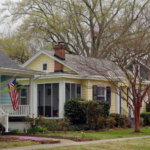With all of the public policy discussion of housing in Virginia, it is useful to examine how burdened Virginians are by the costs of their housing.
Based on brand new data from the Bureau of the Census, the average Virginia homeowner is in pretty good shape compared to others in America.
But still over a third of them carry a cost burden for that housing that exceeds the recommended 30% of household income. Those burdens in turn challenge the futures of the very industries that build and finance housing.
In the case of renters, it is difficult to see how half of them can pay the rest of their bills and save to buy a house.
Just like the rest of American renters.
We’ll take a look. Especially at the outlier case of Virginia Beach.
The Census Bureau, the Federal Reserve, and other federal agencies consider households to be cost-burdened when they spend more than 30% of their income on rent, mortgages and the long list of other housing costs.
The 2021 Bureau of the Census American Community Survey released yesterday answers housing burden questions for the country.
The headline from that release was:
Over 19 million U.S. renter households spent more than 30% of their income on housing costs in 2021, according to data from the 2017-2021 American Community Survey (ACS) 5-year estimates released today.
The survey data indicate that, of Virginia’s homeowners, 35.2% in 2021 were overburdened by the cost of their homes. That was significantly lower than the 41.5% of American homeowners who were similarly burdened.
The average renter in the commonwealth, however, was (within the margin of error) equally burdened with other American renters, of whom an estimated 51% spent more than 30% of their income for housing.
Those are of course percentages, not individual stories.
I have filtered the master 2021 American Community Survey data base to support this article. You can find that tailored report here.
From that, I created a spreadsheet to do some of the math.
Some highlights show regional income-adjusted cost differences within the commonwealth. The sheet displays nationwide, Virginia-wide, Henrico, Roanoke City, Bedford County, Virginia Beach and Fairfax County data.
Among the five chosen jurisdictions, owners and renters in Virginia Beach carry the highest housing cost burdens:
- Roanoke City has the lowest percentage of burdened homeowners, at 27.3%. Virginia Beach has the highest at 39.5%.
- Bedford County has the lowest percentage of burdened renters at 38.3%. Virginia Beach again has the highest at nearly 55%.
Not even Alexandria and Arlington, which I looked at separately, reach the relative levels of Virginia Beach burdens on either homeowners or renters.
The homeowner burden difference is traceable to the very high percentage of Virginia Beach homeowners with mortgages who bear cost burdens above 30% of household income — almost 29% of owners with mortgages.
I cannot find any obvious reason for that in a comparison of Virginia Beach and Fairfax County homeownership data.
Virginia Beach homeowners, for example, are longer-tenured in their current homes than are homeowners in Fairfax County, so the Fairfax County homeowners are in houses they bought further up the inflation curve.
The difference pretty clearly then lies in the major difference in household income between the state’s largest county ($134,115) and its largest city ($81,634).
Bottom lines on affordability. Housing is, for homeowners, not as burdensome in Virginia overall as in the rest of the country.
The regional differences in income-adjusted housing cost burdens in Virginia are significant, and are not distributed the way you might have thought.
The results seem to show regional differences in combinations of housing stock, willing buyers and willing sellers including:
- the relative reluctance or willingness of people to choose housing above the means suggested by household income in order to live where they want to live; and/or
- the housing stock affected by the willingness and ability of builders to build, including the availability and cost of buildable land, and the willingness of local governments to zone housing affordable to the local population.
The interested parties.
It is in the long-term best interests not only of the people, but also the real estate and banking industries, to keep all of that in balance and have people living in housing within their means so they can move up.
Given the dominance of the real estate and banking industries on the Virginia Beach City Council for decades, it may seem to outsiders a bit surprising that they have gotten it wrong here. More short- than long-term thinking. Stupid, in fact.
Having watched that process for decades, it does not surprise me.
But across the Commonwealth those industries have been more successful than in most states for owner-occupied housing.
It is the rental housing market that needs help to provide the next generation of home buyers.
The poor. The poor in these rental market conditions need public help to find the housing they require. Money is needed, but they need efficient and effective public help on the ground, not just budget lines.
That is a different part of the story that I have written about before and will again..


Leave a Reply
You must be logged in to post a comment.